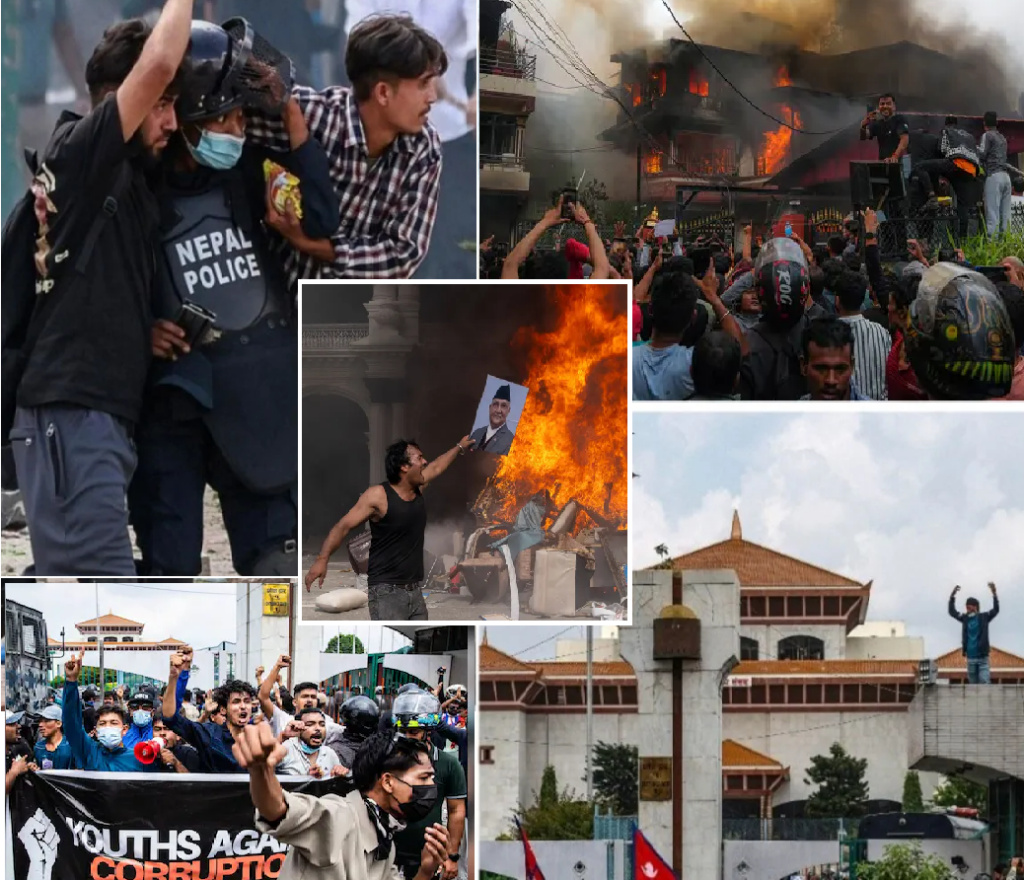
- Gen Z protests erupted after Nepal banned major social media platforms, sparking anger due to high unemployment and reliance on these platforms for livelihoods.
- Government crackdown with shoot-to-kill orders killed 20 protesters, leading to ministerial resignations and army intervention.
- Chronic political instability, corruption, and unmet democratic expectations fueled growing pro-monarchy sentiment and the collapse of communist leadership.
- Balendra Shah emerged as a popular anti-corruption leader as India, China, and the USA watched the crisis for geopolitical implications.
Nepal, the Himalayan nation, is facing an unprecedented crisis as a Gen Z-led protest has turned violent, plunging the country into its most volatile phase in years. The protest, which initially started as an anti-government demonstration, erupted after the Government of Nepal, headed by K. P. Sharma Oli, decided to ban social media platforms such as Meta (Facebook, Instagram), YouTube and X, claiming that these apps had failed to adhere to Nepal’s national laws.
This decision triggered massive protests across the country. Nepal, though a small nation, has nearly 30% of its population working abroad, while unemployment within the country has risen to 12%. For many Nepalis, social media platforms are crucial for livelihood opportunities. The ban thus acted as a catalyst for frustration, bringing thousands onto the streets.
In response, the government cracked down harshly. Security forces fired rubber bullets, and later, a “shoot-to-kill” order was imposed when protests escalated, killing 20 of the protestors. Violence spread as demonstrators began raiding government institutions, including the Prime Minister’s residence and Parliament. The situation spiralled out of control, prompting several ministers in Oli’s cabinet to resign. Eventually, a President-backed military intervention became inevitable, and the Nepali Army was deployed to maintain order.
However, the unrest is not merely about social media. Nepal has been plagued by chronic political instability: in the last 17 years, the country has seen 14 governments, with none completing a full term. Since 2008, when Nepal transitioned from monarchy to democracy, expectations have repeatedly been dashed. Experts argue that democracy in Nepal has failed to deliver stability or governance. This failure has also fueled a growing pro-monarchy sentiment among sections of the population.
Nepal is often ranked among the most corrupt nations, and citizens blame the government for failing to provide basic amenities, employment, and infrastructure. Despite vast potential in hydropower and tourism, the country lags behind with only two international airports and poor development. Many Nepalis are forced to migrate for work. Another source of anger is the children of political elites (“nepokids”) who live in luxury while ordinary citizens struggle.
More Than The Government Protest
Thus, while the ban on social media acted as the immediate trigger, deeper structural issues lie at the heart of the unrest. The political career of K. P. Sharma Oli, who served as Prime Minister four times (first in 2015 during the promulgation of Nepal’s new constitution, later in 2018, 2021, and most recently in 2025), now seems effectively over. His tenure was marred by controversies, from deteriorating India–Nepal ties, such as the Lipulekh border dispute and his provocative claim that Lord Ram was born in Nepal, to his increasing closeness with China.
The protests have also weakened the communist establishment in Nepal. Ironically, communism, which once rose as a revolutionary force against monarchy, is now facing collapse through another popular uprising. For the first time since 2008, Nepal’s political order is at a crossroads, with a vacuum emerging in leadership.
Who is Balendra Shah?
Into this void has stepped Balendra Shah, the independent Mayor of Kathmandu. A rapper-turned-politician who rose to prominence with his songs against corruption, Shah became mayor in 2022 and has since become a popular figure. The youth, particularly the protestors, are now demanding that he take on a national role, potentially as Prime Minister.

Concerns for India
Geopolitically, the upheaval poses challenges. India and Nepal share close cultural and economic ties, along with an open border. Under communist rule, relations with India often soured, yet New Delhi at least found the communists predictable. With the collapse of Oli Sharma’s leadership, India must carefully watch developments and engage with whichever new administration emerges to safeguard its interests.
China Loses while USA Gains!
China, on the other hand, faces a setback. The communist regime had drawn Nepal closer to Beijing, especially in energy and infrastructure projects. With the fall of Sharma, China risks losing influence.
However, the United States of America will likely capitalise on this scenario, as it understands that the removal of the communist regime in Nepal is a positive indication to strengthen its relationship with Nepal and distance it from China. Given the fact that China and the United States of America are rivals, and considering the strategic geopolitical location of Nepal along with its critical resources, whether in the form of hydroelectric energy or its closeness to India, the United States of America will certainly look to expand its engagement.
It is also not that the United States of America has only recently begun this. The Millennium Challenge Corporation, which began in 2017, was a US$500 million grant given to Nepal to develop its energy sector. However, in 2022, under the leadership of Sher Bahadur, major protests erupted, and the project faced obstacles. Still, the United States of America has been keeping a close watch on Nepal.
Recently, the Borderless Banking Service, a project by the U.S.-based fintech company Xuno in collaboration with Nepal’s Siddhartha Bank, was launched with the presence of U.S. Ambassador Dean R. This clearly shows the increasing attempts by the United States of America to build stronger ties with Nepal and reduce Chinese influence. Any setback for China in Nepal is, ultimately, an American gain.
People in Nepal have been hailed for the protest. However, experts sound caution about any popular movement, as world geopolitics and history have shown that any sort of uprising taking place does not necessarily result in the promised outcomes, and the same applies to Nepal as well.
What may be the future of Nepal’s politics remains uncertain, as for the very first time since 2008, Nepal stands at the crossroads, transitioning from communist rule to a new political phase. Things do remain uncertain, but there is a political void inside Nepal. However, that political void is also an opportunity for the new generation of leaders in Nepal to come forward and take the centre stage in Nepali politics.
References:
- https://www.newindianexpress.com/world/2025/Sep/09/kp-sharma-oli-rebel-leader-turned-politician-fails-to-provide-political-stability-to-nepal
- https://www.timesnownews.com/world/nepal-genz-protest-kp-sharma-olis-exit-nepals-political-instability-whats-next-14-governments-in-17-years-article-152740518
- https://www.indiatoday.in/amp/world/story/nepal-gen-z-protest-live-updates-curfew-in-kathmandu-oli-government-in-emergency-huddle-security-forces-use-tear-gas-2783755-2025-09-08
- https://kathmandupost.com/national/2025/09/08/19-dead-in-gen-z-protests-across-nepal
- https://opindia.com/2025/09/lipulekh-dispute-between-india-nepal-united-states-financial-aid-influence-details/
Aayush Pal is a freelance writer on contemporary geopolitical developments. The views expressed in his work are entirely his own.
